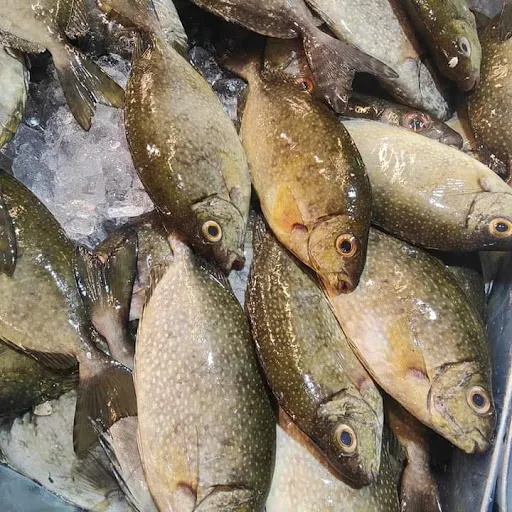Siganus caniculatus, commonly known as the rabbitfish, is a marine fish species belonging to the family Siganidae. It is found in the Indo-Pacific region and is of significant ecological and economic importance.
General Description:
Rabbitfish are characterized by their elongated, laterally compressed bodies and small mouths. They typically have distinctive coloration patterns, often with vertical stripes or spots. Some species have venomous spines along their dorsal and anal fins.
Classification:
Kingdom: Animalia
Phylum: Chordata
Class: Actinopterygii
Order: Perciformes
Family: Siganidae
Genus: Siganus
Species: Siganus caniculatus
Physical Description:
The rabbitfish (Siganus caniculatus) features a flat body with a bluntly rounded snout, exhibiting skin color variations ranging from greenish-gray to yellowish-brown, often adorned with white spots and fine, thin scales. It attains a maximum body length of 40 cm and has a lifespan of 3 to 5 years (Source: 1).
Habitat and Environment:
Rabbitfish primarily inhabit mangrove ecosystems, seagrass beds, and coral reefs in the Indo-Pacific region, but they have also been documented in the Eastern Mediterranean (Source: 2).
Feeding Habits and Lifestyle:
During the day, rabbitfish forage coral reefs and mangroves for food, while at night, they seek refuge within coral crevices. Despite being categorized as herbivores due to their consumption of algae, they also feed on phytoplankton, indicating an omnivorous nature. Their life cycle progresses from small egg sacs to larvae and acronurus. Gonad maturity is reached at around 14.9 cm, with spawning occurring at 16 cm (Source: 3).
Ecological Role:
Rabbitfish play a crucial role in maintaining coral health by grazing on algae layers up to 1-2 mm thick and depositing waste in crevices, thereby promoting coral growth and biodiversity (Source: 4).
Defense Mechanisms:
When threatened or during nighttime, rabbitfish display faded coloration and possess venomous spines as a defense against predators, including humans (Source: 5).
Benefits:
Recommendations:
Rabbitfish suitable for capture are those exceeding 16 cm in length and weighing over 221.6 grams, as they only spawn at this size. Fishing activities are preferably conducted in the late afternoon to avoid capturing undersized individuals (Source: 3).
Conclusion:
Siganus caniculatus, the rabbitfish, is a fascinating marine species with ecological, economic, and cultural significance. Understanding its biology, habitat requirements, and conservation needs is crucial for ensuring the continued health of coral reef ecosystems and sustainable fisheries management.
